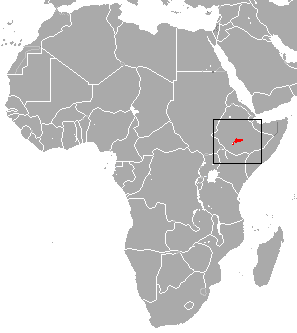Bale Mountains vervet facts for kids
Quick facts for kids Bale Mountains vervet |
|
|---|---|
 |
|
| A Bale Mountains vervet, near Rira, Ethiopia | |
| Conservation status | |
| Scientific classification | |
| Genus: |
Chlorocebus
|
| Species: |
djamdjamensis
|
 |
|
| Bale Mountains vervet range | |
| Synonyms | |
|
Cercopithecus djamdjamensis (Neumann, 1902) |
|
The Bale Mountains vervet (Chlorocebus djamdjamensis) is a special type of Old World monkey. It lives only in the Bale Mountains of Ethiopia, Africa. You can find these monkeys mainly in the bamboo forests there. They are also known as the Bale monkey or Bale Mountain grivet.
These monkeys are quite shy. They usually run away if they see a human. Scientists don't know much about them because they are one of the least-studied monkeys in Africa. They prefer to live in bamboo forests. This is because they love to eat bamboo! Other things like the weather and soil might also play a role in where they choose to live.
What is a Bale Monkey?
The Bale monkey belongs to a group of monkeys called Chlorocebus. There are six other types of monkeys in this group. Before, all these monkeys were thought to be part of a different group called Cercopithecus. That's why the Bale monkey used to be called Cercopithecus djamdjamensis.
Scientists studied the genes of Bale monkeys in 2018. They found that monkeys living in small, separate forests were a bit different from those in large, connected forests. This difference happened because the monkeys in separate forests mixed with other types of monkeys, like the grivet and the vervet monkey. This mixing probably happened a long time ago, over a hundred years ago. Today, Bale monkeys don't usually live near these other monkey types.
What Do Bale Monkeys Eat?
The Bale Mountains vervet is a very picky eater! It's a "specialist" when it comes to food. This means it mostly eats one main thing. For the Bale monkey, that main food is African alpine bamboo (Yushania alpina). Bamboo can make up as much as 77% of their diet!
This makes them unique among their monkey relatives in the Chlorocebus group. Other monkeys in this group eat many different kinds of food. Bale monkeys living in large, connected forests eat about 10 different types of plants. But monkeys in smaller, separate forests eat much more variety. For them, bamboo might be only 2% of their diet!
Scientists are still trying to figure out why some Bale monkeys can eat so many different foods. It might be because they mixed with other monkey types. Or maybe they just learn to adapt when there isn't enough bamboo. This ability to eat different foods is helpful. It means the Bale monkey is not as dependent on bamboo as other picky eaters, like the koala (which mostly eats eucalyptus) or the giant panda (which mostly eats bamboo too).
Sometimes, Bale monkeys live near human villages. When they do, they might eat crops from farms. This can make local people upset, and sometimes they might hunt the monkeys.
Protecting Bale Monkeys
The Bale monkey is currently listed as a vulnerable animal by the IUCN Red List. This means it could be in danger of disappearing if we don't protect it. It's also listed on Appendix II of CITES, which helps control trade of endangered animals.
The biggest dangers to the Bale monkey are:
- Losing their home: People are cutting down forests where the monkeys live. This is called habitat loss.
- Hunting: Local people sometimes hunt the monkeys, especially if they eat crops.
- Mixing with other monkeys: In the future, mixing with grivet and vervet monkeys could also be a threat.
Since these monkeys eat a lot of bamboo, cutting down bamboo forests is a big problem for them. In some areas, like the Sidamo Highlands, there are almost no Bale monkeys left because of human activity.
Luckily, some areas are protected. The Bale Mountains National Park helps keep some monkey groups safe. There's also a plan for a new protected area called the Harena-Kokosa National Forest Reserve. This would help protect even more Bale monkey populations.


